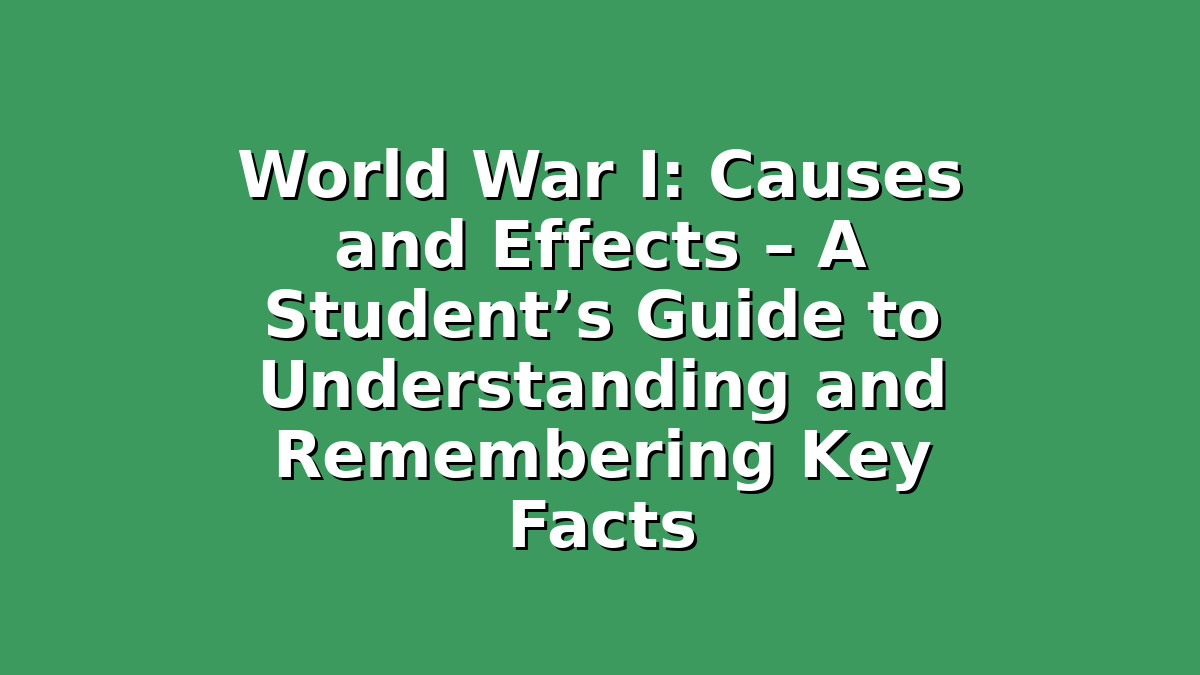World War I, also known as the Great War, was one of the most significant events in modern history. It reshaped countries, changed borders, and influenced global politics for decades to come. For students preparing for exams, understanding the causes and effects of World War I is essential—not only to grasp historical context but also to develop critical thinking skills that can be useful across subjects. This guide will break down the complex origins of the war, explore its major consequences, and provide smart study tips to help you remember important details and excel in your tests.
Introduction: Why Study World War I?
World War I might seem like a distant, complicated event filled with dates, names, and battles, but it’s much more than just memorizing facts. It’s a story about how nations interact, how alliances can lead to conflict, and how the consequences of war can shape the future. For students, this means learning about World War I isn’t just necessary for exams—it’s a way to understand how history influences the world today.
To make your study journey easier, this article will cover the three main areas you need to focus on:
1. The causes of World War I,
2. The effects of the war,
3. Study strategies to help you retain and apply this knowledge effectively.
—
1. The Causes of World War I: Breaking Down a Complex Web
World War I didn’t happen overnight; it was the result of a combination of long-term and immediate factors that created a tense and unstable environment in Europe. Understanding these causes is key to answering exam questions about why the war started.
Main Causes to Remember:
– Militarism: European countries were building massive armies and navies. This arms race made nations ready and eager to use force.
– Alliances: Countries formed secret and public agreements (like the Triple Alliance and Triple Entente) promising to defend each other, which turned a small conflict into a bigger war.
– Imperialism: Competition for colonies and resources heightened rivalries, especially between powers like Britain, France, and Germany.
– Nationalism: Intense pride in one’s nation often led to distrust and hostility, especially in the Balkans where different ethnic groups wanted independence.
– The Spark: The assassination of Archduke Franz Ferdinand of Austria-Hungary in 1914 triggered a chain reaction, leading countries to declare war.
Study Tip: Create a cause-and-effect mind map. Start with “World War I” in the center and branch out to each cause, adding short explanations or examples. Visual aids like these help you see connections and recall information during exams.
—
2. The Effects of World War I: How the War Changed the World
The impact of World War I was enormous, affecting not just the countries involved but the entire globe. Exam questions often focus on political changes, social shifts, and economic consequences.
Key Effects to Focus On:
– Political Changes: The collapse of empires such as Austro-Hungarian, Ottoman, Russian, and German led to new countries forming and political instability.
– Treaty of Versailles (1919): This treaty officially ended the war but imposed harsh penalties on Germany, which sowed the seeds for World War II.
– Economic Impact: Many countries faced heavy debts and economic hardship. The war accelerated technological advancements but also caused widespread destruction.
– Social Changes: The war altered roles, especially for women who took on jobs traditionally held by men. It also led to movements demanding better rights and peace.
– The League of Nations: Established to prevent future conflicts, although it had mixed success.
Study Tip: Use timelines to remember the sequence of events after the war. Mark the end of the war, the signing of treaties, and major political changes. Timelines clarify cause-and-effect relationships and improve your essay writing.
—
3. Study Strategies to Master World War I Content
Preparing for exams on topics like World War I requires more than just reading your textbook. Here are some effective study techniques tailored for history students:
a. Active Note-Taking:
Don’t just copy text. Summarize causes and effects in your own words, and highlight key terms like “militarism,” “nationalism,” or “Treaty of Versailles.” This improves understanding and retention.
b. Practice Past Paper Questions:
Look for exam questions about World War I causes and effects. Writing answers helps you practice structuring essays or short responses, reinforcing your knowledge and timing.
c. Use Flashcards:
Create flashcards for key terms, dates, and people related to the war. Quiz yourself regularly to strengthen recall. Digital apps like Quizlet can make this fun and interactive.
d. Group Study Sessions:
Discuss the causes and effects with classmates. Teaching others is a powerful way to deepen your understanding and expose gaps in your knowledge.
e. Connect to Modern History:
Try to link World War I topics to current events or later history, such as World War II. This broader perspective makes history feel more relevant and memorable.
—
Conclusion: You Can Master World War I!
World War I is a challenging but rewarding topic to study. By understanding the multiple causes that led to the war and the wide-ranging effects it had on the world, you’ll be able to write strong essays and answer exam questions confidently. Remember to use active study methods like mind maps, timelines, flashcards, and practice questions to make your revision more effective and less stressful.
Stay positive and consistent in your study habits, and don’t hesitate to ask teachers or peers for help if you’re unsure about any part of the topic. With these strategies and a clear understanding of the key points, you’ll be well on your way to success.
Good luck with your exams!
—

Responses